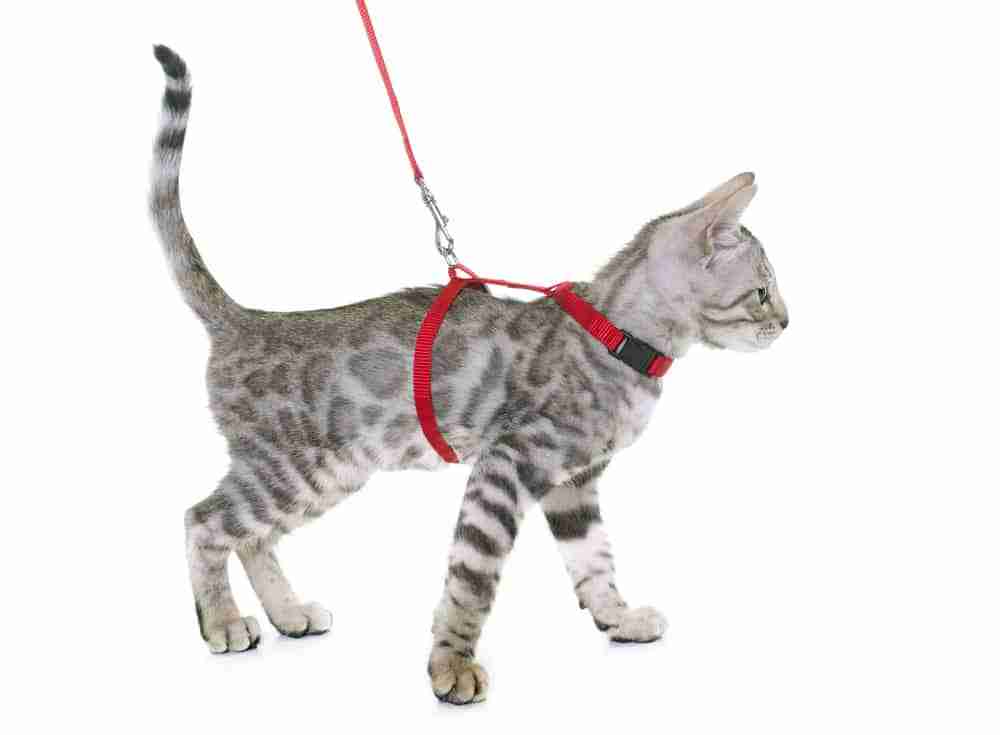Have you got an indoor cat that longs to explore the outdoors? Does your cat turn feral when you visit the vet? When you travel with your cat do you sometimes feel that you should let your cat free to stretch their legs? If you have found yourself considering these questions then you should consider training your cat to walk on a leash.
A cat that can walk on a leash can safely go outdoors. A cat that can wear a leash will probably be easier to handle at a vet when they need attention. A cat that is comfortable on a leash can be set free from confinement when you both need rest breaks on journeys.
Can A Cat Of Any Age Be Leash Trained?
You might think your cat is too old to learn new tricks, but you can teach a cat of any age to walk on a leash. Learning to get by with a leash is more about personalities, learning abilities, the confidence of the cat and your method of getting them to walk on the leash.
Ideally, you would prefer to teach your cat to be comfortable with a leash when they are developing as a kitten when uptake is quick and is not hampered by previous experiences and fears.
In most scenarios, this is just not possible. Often by the time you realize you need to get your cat leash friendly they are older. But fear not, with patience and a step-by-step approach even the oldest, most wary cat can be successfully trained to accept a leash.

What Accessories Do I Need?
You are going to need to invest in a harness and a leash. Specifically, you do not want to attempt this with just a collar. Cats are amazing escape artists and collars are often made to be slipped mainly as a safety feature so a cat doesn’t get caught up. A harness will be harder for your cat to escape from and will ensure their safety whilst on a leash.
A harness should go around the neck and have a loop around the chest behind the shoulders. The two loops, neck and chest, should be joined by a strap. An “H” harness is the minimum you need but more full-bodied “holster” harnesses are just as good or even “figure of 8” harnesses. Some of the best no escape cat harness options are reviewed here.
Any cat harness you choose should have a leash attachment point that is between the shoulder blades rather than at the neck. You don’t want to restrain your cat by the neck, merely exert gentle influence through the shoulders.
The leash itself should be six to eight-foot-long. This is short enough for control but long enough to let your cat safely explore.
A Step By Step Guide To Leash Training Your Cat :

Get Used To The Harness
The first step is to get your cat used to the harness. You are going to have to start out moderately cautiously if you want to be successful. Initially, you should aim to increase your cat’s awareness of the harness and get them to associate the harness with good vibes.
The best way to achieve this is to leave the harness in plain sight so they can investigate the harness at their leisure, then after a day or so, you should have the harness near the food source so your cat associates the harness with good things – getting fed!
Once your cat broadly accepts the existence of the harness you come to what could be a difficult stage. You need to get your cat used to wearing the harness. Initially, you need to try to fit the harness very loosely for a short period of time.
If your cat is utterly resistant, you may need to drape the harness on the cat for the cat to get used to the sensation of the harness on their back. You may need to do this in short bursts, with treats associated, until your cat realizes the harness is not a big issue.
Once your cat is generally accepting of the harness on their back then you can fit the harness with increasing snugness for increasing durations until your cat is comfortable wandering around in the harness. You may have to go from one-minute bursts of harness wear to longer durations to get full acceptance from your cat! The harness should fit snugly but allow you to get two fingers between the harness and your cat to ensure a decent but comfortable fit.
A word of warning – your cat may collapse, flop or go limp when you fit a harness. Fear not! This is an inherited survival response. Your cat automatically flops if it thinks it is being grabbed by a predator and will go limp waiting for an escape opportunity – move through the zone with treats acting as a distraction ploy. You may have to repeat this process several times.

Introduce The Leash
This is a relatively easy step. All you have to do is get your cat, now in a harness, used to the weight of the leash.
Simply attach the leash to the harness and let your cat go about its business within your home. Dragging the leash around will get your cat used to the weight of the leash and familiar with its presence and minor pull. Make sure your cat doesn’t get snagged up on furniture or tangled and you are good to go! This phase should be relatively easy compared to getting your cat in a harness but don’t be tempted to rush it – your cat still needs to get familiar and learn that the leash is essentially harmless!
Go Outdoors
The big moment has now arrived – your cat is used to the harness and the leash and is ready to go for an explore!
At this stage, you should carry your cat outdoors and place them on the ground. You are not going to walk your cat like a dog, to heel. You are going to allow your cat to take you for a walk…if they want! The idea is to allow your cat to explore the outdoors safely and get acclimated to a completely new environment at their own pace.
You should not drag them about on an exploration. They are probably going to be on full alert due to being in an unusual environment and restricted by the harness and leash. Initially, and we are talking about the first few experiences, you need to let them gain confidence.
With time your cat should get more familiar with the sensation and might even be so confident that they are happy walking into completely new environments or even walking alongside you!
Much of what you will be able to do on the leash will be down to your cat’s personality once they are happy with the leash. Like people, some cats are more outgoing, curious and confident!
